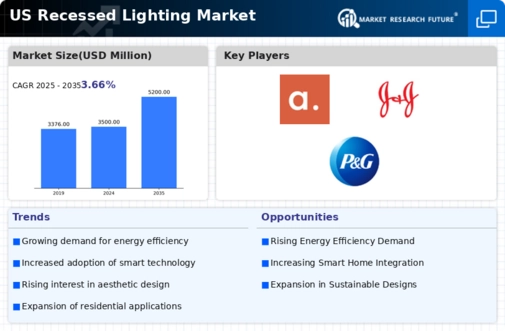Expansion of Commercial Spaces
The recessed lighting market is poised for growth due to the expansion of commercial spaces across various sectors. As businesses seek to create inviting and functional environments, the demand for effective lighting solutions has surged. Recessed lighting is particularly favored in commercial settings for its ability to provide uniform illumination while maintaining a clean aesthetic. Recent data indicates that the commercial construction sector is expected to grow by 8% annually, further driving the need for recessed lighting installations. This trend is particularly evident in retail, hospitality, and office spaces, where lighting plays a crucial role in enhancing customer experience and employee productivity. As a result, the recessed lighting market is likely to benefit from increased investments in commercial projects, potentially leading to a market valuation exceeding $1.5 billion by 2027.
Shift Towards Sustainable Living
The recessed lighting market is witnessing a notable shift towards sustainable living practices among consumers. As environmental concerns become more prevalent, individuals are increasingly seeking lighting solutions that minimize their ecological footprint. Recessed lighting, particularly LED options, aligns with this trend by offering energy-efficient alternatives that reduce electricity consumption and greenhouse gas emissions. Recent surveys indicate that over 70% of consumers are willing to invest in sustainable products, which bodes well for the recessed lighting market. This growing inclination towards eco-friendly solutions is likely to drive innovation and competition among manufacturers, as they strive to meet consumer demands for sustainability. Consequently, the market may experience a significant uptick in growth, with projections suggesting an increase in sales by approximately 20% over the next five years, as more consumers prioritize environmentally responsible choices.
Rising Demand for Home Renovations
The recessed lighting market is benefiting from an increasing trend in home renovations across the United States. Homeowners are investing in upgrades to enhance the aesthetic appeal and functionality of their living spaces. According to recent data, approximately 60% of homeowners plan to undertake a renovation project within the next year, with lighting being a key focus area. Recessed lighting offers a sleek and modern solution that complements various interior designs, making it a popular choice among homeowners. This growing demand for home improvements is likely to propel the market, as consumers seek to create inviting atmospheres while increasing property value. The trend suggests that the recessed lighting market could see a substantial increase in sales, potentially reaching $2 billion by 2026, driven by the desire for contemporary and efficient lighting solutions.
Technological Advancements in Lighting
The recessed lighting market is experiencing a surge due to rapid technological advancements in lighting solutions. Innovations such as LED technology have transformed the industry, offering energy-efficient options that consume up to 75% less energy than traditional incandescent bulbs. This shift not only reduces energy costs for consumers but also aligns with the growing emphasis on sustainability. Furthermore, the integration of smart technology into recessed lighting systems allows for enhanced control and customization, appealing to tech-savvy consumers. As a result, the market is projected to grow significantly, with estimates suggesting a compound annual growth rate (CAGR) of around 10% over the next five years. This trend indicates a robust demand for modern lighting solutions that cater to both functionality and aesthetics, thereby driving the recessed lighting market forward.
Increased Awareness of Energy Regulations
The recessed lighting market is influenced by heightened awareness of energy regulations and standards in the United States. Government initiatives aimed at promoting energy efficiency have led to stricter regulations regarding lighting products. For instance, the Department of Energy has implemented guidelines that encourage the use of energy-efficient lighting solutions, including recessed fixtures. As consumers become more informed about these regulations, there is a growing preference for products that comply with energy efficiency standards. This shift is likely to drive demand for recessed lighting options that not only meet regulatory requirements but also offer long-term cost savings. The market is expected to expand as manufacturers innovate to create compliant products, potentially increasing market value by 15% over the next few years. This trend underscores the importance of regulatory compliance in shaping consumer choices within the recessed lighting market.














Leave a Comment